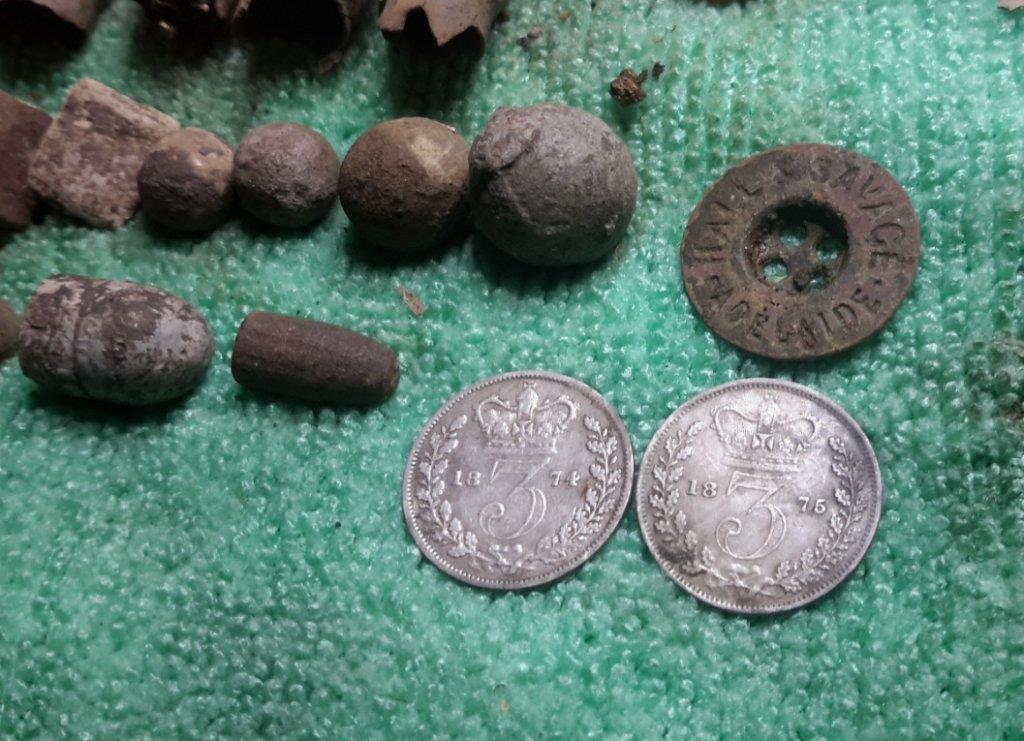Goldpick
Chris Johnson
Just thought I would cover a topic of interest to myself, and possibly others on whether you should investigate iron/low tone targets as being actual coin targets on the Deus.
This came to light at my Victorian coin location when I decided to dig a couple of these deep, scratchy, faint low tones that might have otherwise been overlooked as junk targets. As it turned out, a couple of these targets were actually 1800's threepences, most likely sitting on edge, hence the poor response, and no ID.
The thing that did spark my interest was the repeatable tone on each sweep, and the fact that the target never wandered onto the ferrous side of the horseshoe indicator. Essentially the coin was beyond the effective range for the detector to give anything like a high tone as you would expect for a .925 silver coin, so the tone starts to drop down as a low conductor or almost an iron sounding target. I'm sure if the coin saw the full face of a threepence at the depths I am looking at (8-9"), it would still have come up as a faint high tone using the Hot Program - the main difference being the angle of the coin showing a thin section to the coil that most likely lowers the tone.
In a junky park you may struggle to hear such tones from amongst other densely packed targets, though where I detect most in ground targets are few and far between, hence any dodgy targets are reasonably easy to isolate. Next time I am out I will be deliberately targeting a lot of these often overlooked tones to see what ratio of targets are actual coins, and what is junk (typically low conductor copper flakes)
If the target isn't being masked by nearby iron/junk, it may also pay to investigate further by dropping your reactivity right back to a minimum, turn off the silencer, slow down your sweep speed, and set to 12kHz to try and get the tone to clean up. Pinpointing should also give a fair indication of a stronger coin sized object vs say the brief pinpoint tone of a very thin flake of copper or other small/thin non-ferrous junk.
So something to think about when at the stage of cleaning out a site, and are struggling to come up with anything like an obvious coin tone.
One these threepences were found investigating a scratchy low tone at the base of a tree, not something I would have usually thought about digging when looking for high conductor targets.

This came to light at my Victorian coin location when I decided to dig a couple of these deep, scratchy, faint low tones that might have otherwise been overlooked as junk targets. As it turned out, a couple of these targets were actually 1800's threepences, most likely sitting on edge, hence the poor response, and no ID.
The thing that did spark my interest was the repeatable tone on each sweep, and the fact that the target never wandered onto the ferrous side of the horseshoe indicator. Essentially the coin was beyond the effective range for the detector to give anything like a high tone as you would expect for a .925 silver coin, so the tone starts to drop down as a low conductor or almost an iron sounding target. I'm sure if the coin saw the full face of a threepence at the depths I am looking at (8-9"), it would still have come up as a faint high tone using the Hot Program - the main difference being the angle of the coin showing a thin section to the coil that most likely lowers the tone.
In a junky park you may struggle to hear such tones from amongst other densely packed targets, though where I detect most in ground targets are few and far between, hence any dodgy targets are reasonably easy to isolate. Next time I am out I will be deliberately targeting a lot of these often overlooked tones to see what ratio of targets are actual coins, and what is junk (typically low conductor copper flakes)
If the target isn't being masked by nearby iron/junk, it may also pay to investigate further by dropping your reactivity right back to a minimum, turn off the silencer, slow down your sweep speed, and set to 12kHz to try and get the tone to clean up. Pinpointing should also give a fair indication of a stronger coin sized object vs say the brief pinpoint tone of a very thin flake of copper or other small/thin non-ferrous junk.
So something to think about when at the stage of cleaning out a site, and are struggling to come up with anything like an obvious coin tone.
One these threepences were found investigating a scratchy low tone at the base of a tree, not something I would have usually thought about digging when looking for high conductor targets.




